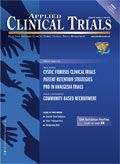How Best to Mitigate the Risk in Clinical Research
Applied Clinical Trials
We are now being encouraged by regulators worldwide to re-think our approach to monitoring and apply risk-based monitoring strategies rather than continue with our more traditional approaches.
Working in a risk averse society means we are under constant pressure to ensure that clinical trial data is both credible and accurate. The risk of flawed data which could jeopardize patient safety and ultimately lead to the rejection of the drug during a marketing application is unthinkable. We are now being encouraged by regulators worldwide to re-think our approach to monitoring and apply risk-based monitoring strategies rather than continue with our more traditional approaches.

When considering risk in clinical trials, the complexity of study design/study characteristics, treatment, and safety needs to be considered. Study characteristics can include the phase, type of blind, and patient characteristics. Treatment risk categories may include the requirement for invasive surgery, whether a combination of drugs are to be administered, as well as the route of administration. The investigational medicinal product licensing status, safety data, and pharmacological class should also be taken into account. When considering subject safety, an assessment of the number of serious adverse events that are related and expected as well as the type of statistical analyses that are planned to be performed should be considered. Some organizations may consider geography, because subject demographics, standards of care, and the extent of clinical trials infrastructure can vary depending on the location of the sites. Investigator experience and expertise is critical to the success of a study and can be a factor used in this type of assessment. The risk score can be weighted differently on some of the items.

Once the level of risk has been defined, a monitoring plan can be developed to define the strategy. The level of effort should be proportional to the risks perceived with increased effort allocated to areas of greatest risk to patients. Triggered on-site monitoring, remote centralized monitoring, as well as a hybrid approach which combines all three can be applied. High-risk areas, studies involving seriously ill subjects or vulnerable populations will be better served by standard on-site monitoring to ensure appropriate protection is provided. Risk assessment is not a one-time event; it is important to continually re-evaluate and reassess risk throughout the course of a study and amend as needed. It is important to perform a risk assessment and have a mitigation plan in place prior to the start of the study.
Resources need to be focused on high-risk studies, and regular on-site monitoring should be performed. Also, site selection and site training need to be carefully considered. Early areas of risk can be identified, responsiveness observed, and the general comprehension of study procedures can be assessed. Studies that fall into the medium risk category may be subject to more flexible on-site monitoring. Low-risk studies may require little to no time for monitoring. Instead, centralized monitoring techniques can be applied. The time allocated for site selection and site training may also be reduced. Risk-adaptive monitoring can only be considered if technologically advanced systems can provide almost real-time data to track site performance, and thereby allow attention to be focused on any areas that require attention.
It was never a requirement of ICH GCP to conduct 100% source data verification and monitor every site in every study. Many organizations spend too much time trying to avoid potential audit or inspection findings rather than concentrating on the important issue of risks to the patient. Once we have evaluated the risk and defined the necessary risk mitigation plans, we can be assured that there is the necessary oversight, and any trends which could have significant impact are detected.
Christine de Balincourt Head Quality Assurance & Control Unit, EORTC E-mail: [email protected]
Nicky Dodsworth Chair Education Working Party, EFGCP Vice-President Global QA, Premier Research E-mail: [email protected]

FDA Fast Tracks Johnson & Johnson’s Nipocalimab for Fetal Neonatal Alloimmune Thrombocytopenia
March 27th 2024Johnson & Johnson is moving forward with a pair of Phase III trials of nipocalimab to reduce the risk of fetal neonatal alloimmune thrombocytopenia in alloimmunized pregnant patients.
Citius Pharmaceuticals Resubmits BLA to FDA for Lymphir to Treat Cutaneous T-Cell Lymphoma
March 19th 2024Pivotal Phase III Study 302 trial data show an objective response rate of 36.2% based on an independent review committee assessment in the treatment of relapsed/refractory cutaneous T-cell lymphoma.